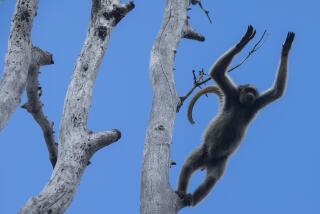Two studies, two answers: When exactly did mammals emerge?
- Share via
Mammals first appeared 215 million years ago during the Triassic period, according to a new study in the journal Nature. Wait, no, they first showed up 175 million years ago during the Jurassic period, said another study in the same issue of the journal.
Who’s right? The answer may rest in the middle of your ear.
A bit of background: The origin of our mammalian ancestors has long been shrouded by an incomplete fossil record. The first breakthrough occurred during World War II, when German paleontologist Walter Georg Kühne was imprisoned in Britain and filled his hours by examining fossils. He described Morganucodon, an unremarkable shrewlike creature thought to be among the earliest mammals, if not the earliest mammal.
Over the ensuing decades, paleontologists discovered a smattering of other proto- and early-mammal fossils that looked and acted a lot like Morganucodon, “omnivore-kind-of-things running around the feet of dinosaurs,” said University of Oregon paleontologist Samantha Hopkins, who was not involved with either Nature study.
But one group of fossils baffled the paleo crew — those belonging to the order Haramiyida, a furry band of pseudo-rodents that in some ways seemed like modern mammals, and in others like mammal ancestors.
Everything the scientists knew about Haramiyida came from examining scattered teeth and a piece of jawbone. The scattered teeth were crucial, because teeth are the single most important body part for identifying mammal fossils, reflecting much about a species’ diet and lifestyle.
“Give me one tooth, and I can probably identify the species,” said Jin Meng, curator of paleontology at the American Museum of Natural History and the senior author on one of the studies. But “if you give me the whole skeleton without the teeth, I will hesitate to say what it is.”
The Nature papers deal with two separate fossils from China, dated to 160 to 165 million years ago, that shed light on Haramiyida’s true identity. One fossil included a complete skeleton, and the other was mostly complete, representing a significant upgrade over the handful of teeth previously known.
The fossils were discovered in the same rock formation by two independent teams of paleontologists.
The group led by Zhe-Xi Luo, senior author of the second study and a paleontologist at the University of Chicago, acquired its fossil — a complete skeleton embedded in shale, albeit crushed and flattened — from the Paleontological Museum of Liaoning in China, which bought it from the community of fossil prospectors who scour remote regions of the country.
Naming the creature Megaconus, Luo and his team used CT scans and advanced microscopy to examine as many parts of its anatomy as possible, paying special attention to the teeth and ear bones, which are also vital for identification. They found that the beast was quite the Frankenmammal — it was the size of a large squirrel, walked like an armadillo and had fur, except on its stomach.
When their analysis was complete and they had built a family tree of Megaconus and several of its relatives (both fossilized and modern), they determined that the animal belonged to the Haramiyida, and that the enigmatic group preceded the rise of the mammals, believed to have occurred 175 million years ago.
The other team, led by Jin Meng, came to a different conclusion: that their creature, dubbed Arboroharamiya because of its tree-dwelling habits, was also a Haramiyidan but that Haramiyidans were, in fact, mammals.
Because past research indicates that Haramiyidans arose 215 million years ago, they reasoned further, so too did the mammals — about 40 million years earlier than Luo’s team believes.
The discrepancies between the team’s conclusions hang on the anatomy of the middle ear, said the University of Oregon’s Hopkins.
Virtually all mammals have a middle ear bone that enables them to amplify sound. In fish and in reptiles, the bone is attached to the jaw, but as those animals evolved and mammals arose, the bone migrated to the middle ear, she said.
Both fossil teams were limited by imperfect material (Arboroharamiya was missing its skull), but felt they had enough evidence to know what the ear bones looked like. Luo’s team said that the middle ear bone of Megaconus was still attached to the jaw, showing it wasn’t a mammal. Meng’s team said Arboroharamiya’s middle ear bone was where it should be in mammals.
Both teams said they were not aware of each other’s research until shortly before the studies went to press. Now that their work is out there, perhaps it’s time for a collaboration?
“Put those specimens in a box and drive on over there!” Hopkins implored the groups.
Return to Science Now.
Follow on Twitter: @BradBalukjian






